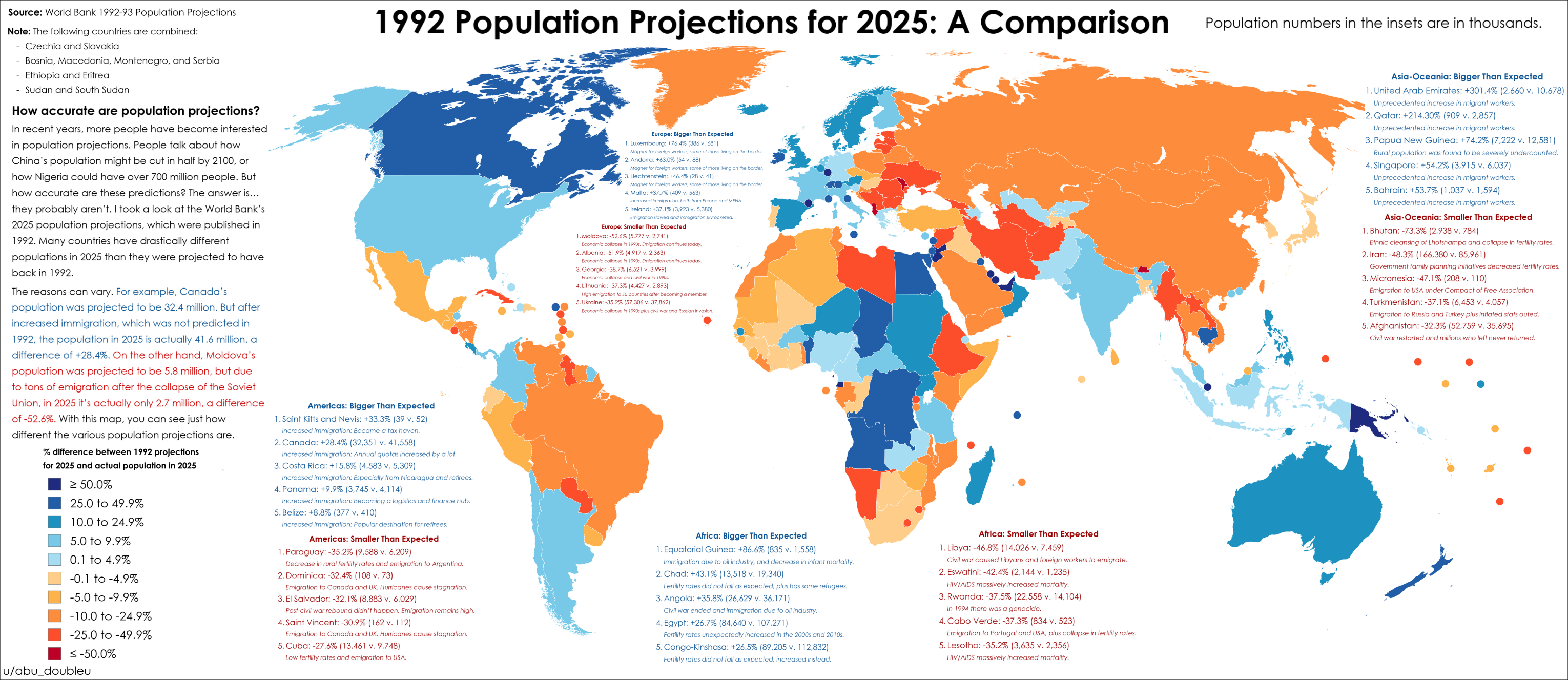2025 Population Projections Accuracy Map


Marcus Rodriguez
Historical Geography Expert
Marcus Rodriguez specializes in historical cartography and geographic data analysis. With a background in both history and geography, he brings unique...
Geographic Analysis
What This Map Shows
The map titled "How accurate were 2025 population projections from 1992?" provides a striking visual representation of the actual population figures for various regions compared to what was predicted over three decades ago. It highlights the disparities between projected and actual populations, allowing us to analyze trends and shifts in demographics over time. This map serves as a vital tool for understanding how historical projections can influence current and future planning in social, economic, and environmental contexts.
Deep Dive into Population Projections
Population projections are essential for urban planning, resource allocation, and public policy. They are typically based on factors such as birth rates, death rates, and migration patterns. The 1992 projections for 2025 were shaped by the demographic trends of that era, which saw increasing urbanization and globalization. At that time, many demographers were optimistic about economic growth and its potential to sustain larger populations in urban centers.
However, the actual population figures reveal a more complex picture. For instance, some regions experienced population booms due to migration from rural areas, while others faced declines due to aging populations and lower birth rates. Interestingly, projections often underestimated the impact of significant events, such as economic downturns or pandemics, which can drastically alter demographic trends.
To illustrate, consider the United States. The 1992 projections anticipated a more significant population increase than what has been observed, particularly in certain states. Factors such as the 2008 financial crisis and recent trends of remote work have changed migration patterns significantly. In contrast, areas like Texas and Florida have seen substantial growth, becoming attractive due to job opportunities and warmer climates, which was somewhat foreseen but not to the extent that actual numbers reflect.
Additionally, global trends such as declining birth rates in developed countries have been more pronounced than expected. Countries in Europe and East Asia, which were predicted to maintain stable growth, have seen their populations stagnate or even decline, leading to concerns about labor shortages and economic viability.
What’s fascinating is how these projections can shape policies. Governments often use this data to plan for infrastructure, healthcare, and education. When projections are inaccurate, it can lead to either overinvestment in certain areas or shortages in others, causing a ripple effect in economic and social systems.
Regional Analysis
Examining different regions, the disparities in population projection accuracy become more apparent. In North America, for instance, the Midwest faced a population decline, which was not anticipated in the 1992 projections. States like Ohio and Michigan have seen significant drops due to industrial decline and youth migration to coastal cities in search of better opportunities. In contrast, the South has experienced rapid growth, significantly fueled by immigration and a booming job market.
Moving to Europe, the projections for countries like Germany and Italy were overly optimistic. The aging population and low birth rates have resulted in populations that are not only smaller but also older than anticipated, putting pressure on social services. On the other hand, regions in Eastern Europe, which were expected to see greater emigration, found that many young people returned, thereby stabilizing their populations more than the projections indicated.
Africa, however, showcased a different narrative. The continent was projected to grow exponentially, and while the growth has indeed been significant, the challenges of urbanization, healthcare, and education remain pressing issues. Countries like Nigeria and Ethiopia have outpaced projections due to high birth rates and migration from rural areas to cities. This has led to megacities emerging at a rate faster than urban planners can accommodate, highlighting the importance of accurate projections.
Significance and Impact
Understanding the accuracy of population projections is crucial for policymakers, urban planners, and businesses. As we navigate through the 21st century, the implications of these projections become ever more critical. With issues such as climate change, economic fluctuations, and global health crises, the ability to anticipate population trends can significantly influence how societies adapt to these challenges.
Current trends indicate that urban areas will continue to grow, but the nature of that growth will be shaped by various factors, including economic opportunities, environmental conditions, and migration policies. Future projections may need to incorporate more flexible models that account for sudden changes in global dynamics. The accuracy of these projections can help us prepare better for the future, ensuring that resources are allocated efficiently and that societies remain resilient in the face of change.
In conclusion, the exploration of the accuracy of past population projections offers invaluable insights into our demographic landscape. It highlights the importance of adaptability in planning and encourages ongoing dialogue about how we can better predict and respond to human population trends.
Visualization Details
- Published
- August 15, 2025
- Views
- 104
Comments
Loading comments...